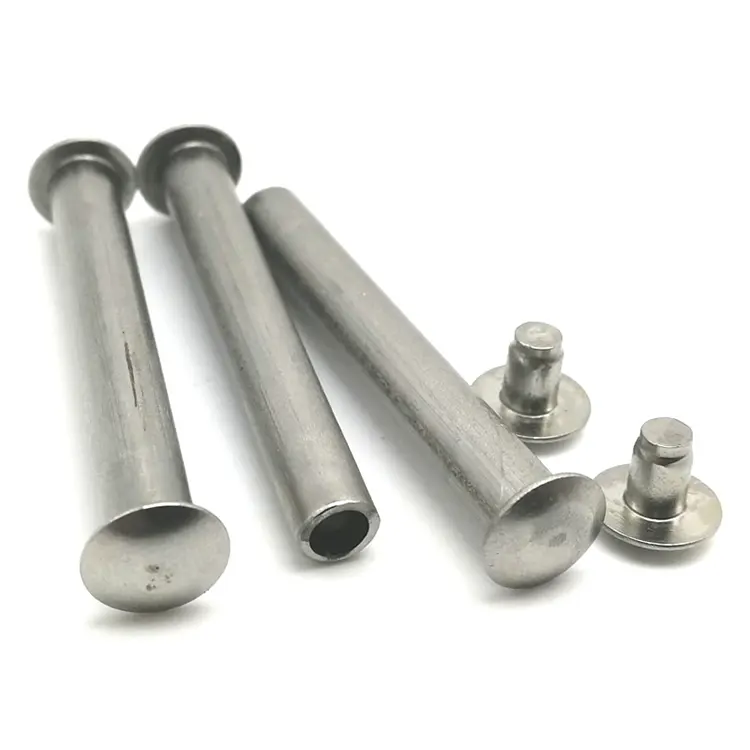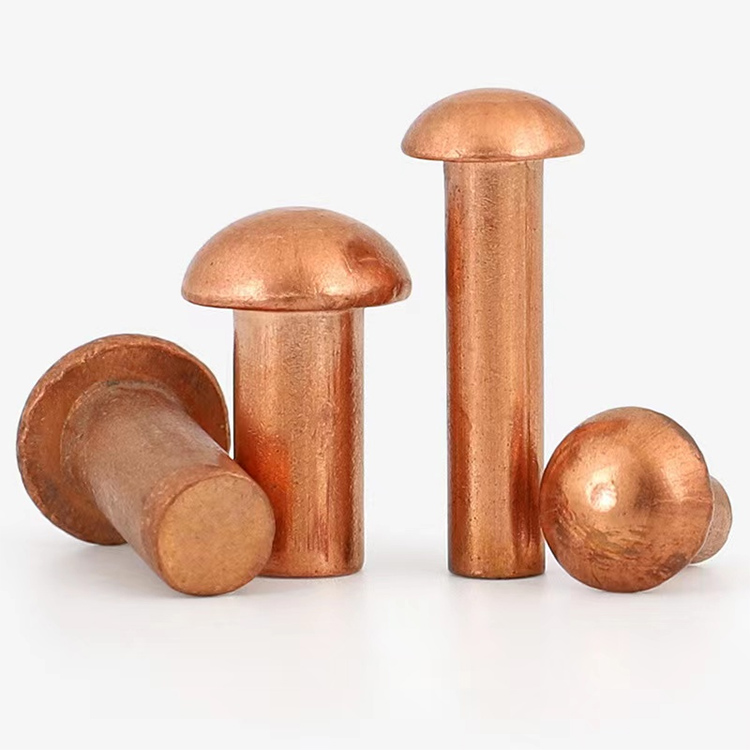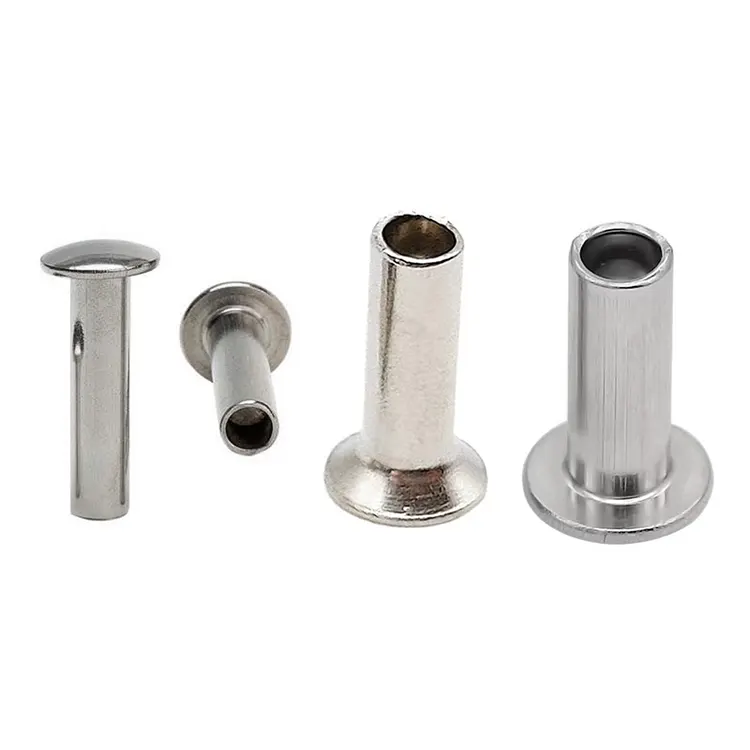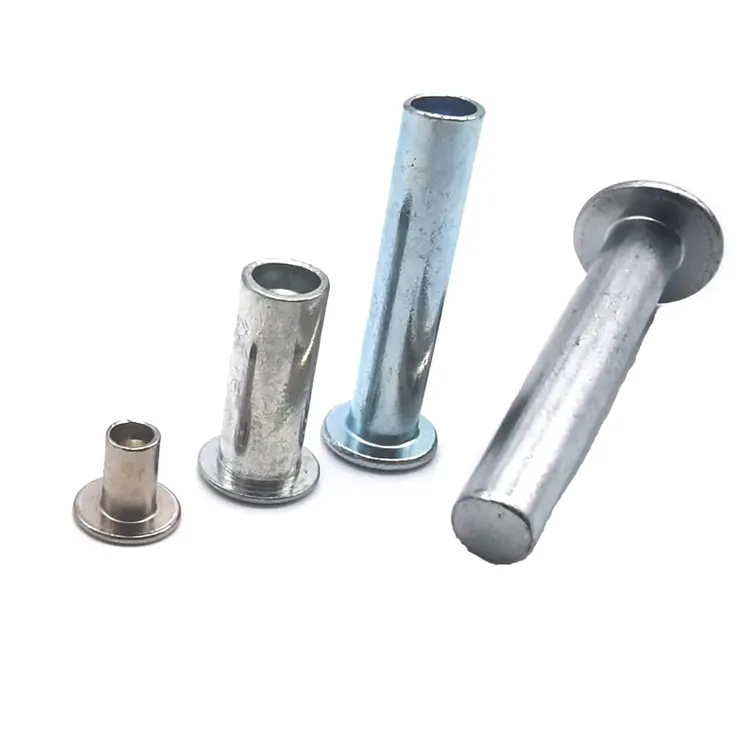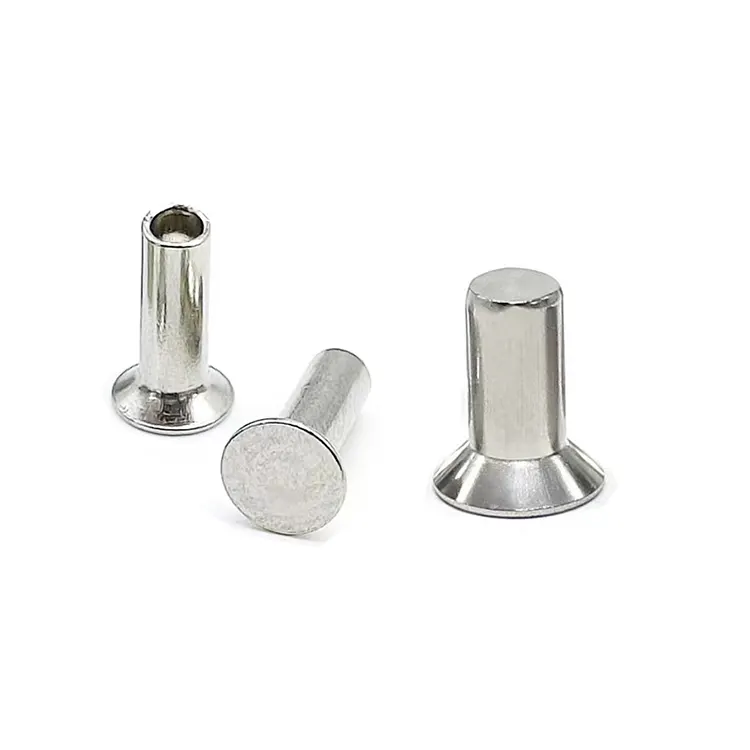Rivets
As one of professional manufacturer in China, Notin would like to provide you Rivets. And we will offer you the best after-sale service and timely delivery.
What is a rivet?
A rivet is a permanent mechanical fastener used to join two or more materials. Rivets work by inserting a metal pin into an aligned hole and deforming the end, creating a strong, secure, and durable connection. Unlike temporary fasteners like screws, rivets do not rely on threads, but instead form a permanent connection, making them ideal for applications requiring high strength, durability, and vibration resistance.
Classification of Rivets
Rivets are typically categorized by head shape, degree of hollowness, or material.
Based on head shape, rivets can be classified as flat head rivets, round head rivets, countersunk head rivets, mushroom head rivets, universal head rivets, truss head rivets, etc.

Based on degree of hollowness, rivets can be classified as solid rivets, semi-tubular rivets, or full tubular rivets.
Based on material, rivets can be classified as brass rivets, stainless steel rivets, steel rivets, aluminum rivets, copper rivets, etc.
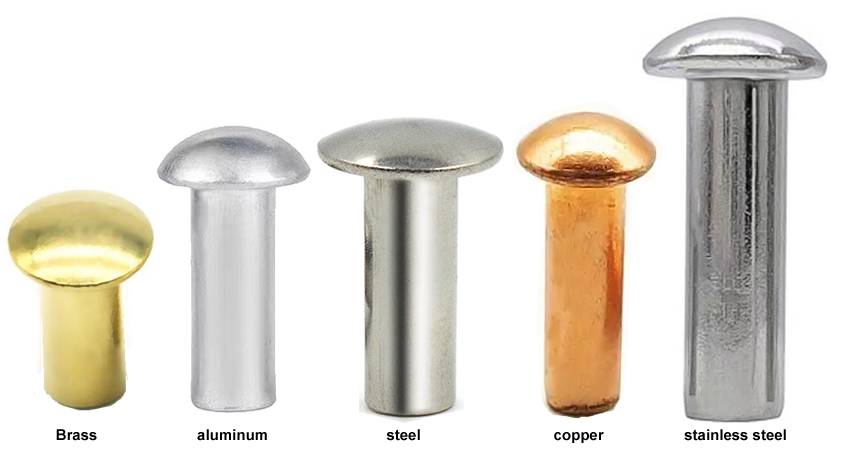
What surface finishes are available for rivets?
Rivet surfaces are typically treated with rust-proofing treatments, primarily electroplating, including zinc plating, nickel plating, chrome plating, tin plating, gold plating, and silver plating. Electroplating is a common rust-proofing method for rivets. It applies a layer of plating to the rivet surface through physical or chemical methods. The plating effectively prevents corrosion and rust, while also providing a certain aesthetic effect.
Another special surface treatment method is head coating. Head coating is performed after the rivet is electroplated. This allows for a variety of colors on the rivet head, achieving an aesthetically pleasing finish.
Aluminum rivets cannot be electroplated, but they can be anodized. Anodizing also allows for a variety of color options, but the unit price is higher than electroplating.
Rust-proofing the rivet surface is crucial, effectively extending the rivet's service life and ensuring a secure connection. Different rust-proofing methods are suitable for different environments and applications, so the choice should be tailored to the specific situation.
- View as
Rivets à tête plate en fer
En tant que connecteur mécanique courant, les rivets à tête plate en fer occupent une position importante dans plusieurs domaines industriels en raison de leurs caractéristiques de conception et de leur large gamme d'applications. Structurellement, la tête du rivet est plate, en forme de disque et le corps est cylindrique. L'extrémité est spécialement traitée pour former une structure bouleversée. Après l'installation, la pression ou l'impact provoque l'expansion du corps, formant un engagement mécanique avec la paroi du trou pour obtenir un effet de serrage. Par rapport aux rivets à tête ronde ou aux rivets à tête fraisée, la conception à tête plate présente des avantages significatifs en termes de répartition de la force et de zone de contact. Par exemple, lorsqu'elle est soumise à une force de cisaillement, sa tête en forme de disque peut disperser la charge sur une plus grande surface, réduisant ainsi efficacement la pression par unité de surface.
En savoir plusenvoyer une demandeRivets à tête fraisée en fer
La tête d'un rivet à tête fraisée en fer a la forme d'un cône tronqué, le cône étant généralement incliné à 90° ou 120° par rapport à l'axe du rivet. Cette forme permet à la tête du rivet d'affleurer la surface du composant connecté après l'installation, ce qui donne un aspect lisse. Ceci est particulièrement adapté aux applications où la planéité de la surface est critique. Venez chez Nuote Metals pour personnaliser le rivet à tête fraisée en fer de votre choix. Nos ingénieurs, avec plus de 10 ans d’expérience, connaissent parfaitement la production de différents types de rivets.
En savoir plusenvoyer une demandeRivets demi-tubulaires
Un rivet demi-tubulaire est une attache métallique solide à une extrémité et partiellement creuse à l'autre, généralement constituée de matériaux tels que l'alliage d'aluminium, le cuivre ou l'acier. La partie creuse occupe environ un tiers à la moitié de la longueur du corps du rivet. Cette conception permet au rivet d'obtenir un effet de fixation grâce à la déformation par extrusion lors de l'installation. Par rapport àrivets solides, les rivets demi-tubulaires se caractérisent par leur légèreté, leur installation facile et leur large applicabilité ; par rapport aux rivets entièrement creux, ils offrent une résistance et une stabilité supérieures. Les rivets demi-tubulaires ne nécessitent pas d'équipement complexe lors de l'installation et peuvent généralement être complétés avec des outils manuels ou pneumatiques. Ils sont donc privilégiés dans de nombreux domaines. Nuote Metals se spécialise dans la production de rivets demi-tubulaires, avec une gamme complète de moules et accueille la personnalisation.
En savoir plusenvoyer une demandeRivets demi-creux
Nuote Metals est situé à Dongguan, en Chine, nous sommes spécialisés dans la production d'une variété de rivets, notammentrivets solides, rivets semi-tubulaires, etrivets tubulaires complets. Les rivets demi-creux sont une fixation industrielle courante, dotés d'une structure à âme creuse avec une tête et une tige semi-fermées. Cette conception leur permet de combiner légèreté et haute résistance, ce qui les rend largement utilisés dans les applications nécessitant un rivetage efficace. Par rapport aux rivets pleins, les rivets demi-creux réduisent le poids en utilisant moins de matériau, tout en exploitant la déformation plastique lors du rivetage pour obtenir une connexion sécurisée, ce qui les rend particulièrement adaptés aux applications sensibles au poids.
En savoir plusenvoyer une demandeRivets à tête plate
Nuote Metals se spécialise dans la fabrication de rivets, produisant une variété de matériaux tels que l'acier inoxydable, le laiton, l'aluminium, l'acier au carbone et le cuivre. Les rivets sont des éléments de fixation couramment utilisés dans diverses structures et assemblages, tant dans la fabrication industrielle que dans la vie quotidienne. Les rivets à tête plate sont le produit de choix pour de nombreuses industries en raison de leurs performances et de leur adaptabilité uniques.
En savoir plusenvoyer une demandeRivets à tête fraisée
Les rivets à tête fraisée sont une fixation mécanique courante, principalement utilisée pour les applications de fixation nécessitant une résistance élevée et une surface lisse. Leur conception à tête fraisée leur permet d'affleurer la surface de la pièce après l'installation, éliminant ainsi toute saillie qui pourrait affecter l'apparence ou la fonction. Les rivets pleins fraisés, quant à eux, sont construits à partir d’une seule pièce de matériau solide, sans aucune section creuse. Ils sont généralement utilisés pour relier professionnellement des pièces par martelage ou rivetage. Il existe également un rivet semi-tubulaire à tête fraisée, avec une section creuse à l'extrémité pour un rivetage plus facile et moins laborieux que les rivets pleins.
En savoir plusenvoyer une demandeWhat are the advantages of rivets over other fasteners?
1. Ease of Installation
Rivets are fast to install, and even fully automated for high-volume applications, resulting in a simple and efficient operation process.
2. Connection Reliability
The riveting process is standardized, with strict quality control, resulting in highly stable connections. Visual inspection allows for quick verification of connection quality.
3. Vibration and Impact Resistance
Rivets connect through deformation or interference fit, providing strong clamping force and excellent vibration resistance, capable of withstanding vibration and shock.
4. Low Cost
Rivets are easy to install and can be fully automated, saving significant labor costs.
What are the advantages and disadvantages of rivets made of different materials?
Aluminum Rivets
Advantages: Lightweight, reduces overall product weight, low cost, suitable for general civilian applications.
Disadvantages: Low tensile and shear strength, unsuitable for high-strength workpieces, prone to electrochemical corrosion when in contact with metals such as stainless steel.
Stainless Steel Rivets
Advantages: Strong corrosion resistance, high hardness, suitable for high-strength workpieces (such as marine equipment)
Disadvantages: Higher cost, typically more expensive than aluminum rivets of the same specification.
Brass and Copper Rivets
Advantages: Excellent conductivity (such as connecting electronic components), good corrosion resistance.
Disadvantages: Higher cost, more difficult to process.
Steel Rivets
Advantages: High hardness, high connection reliability, and wide applicability.
Disadvantages: Compared to other materials, iron rivets are more prone to rusting.
What are the main applications of rivets?
Rivets have a wide range of uses, from small items like a pair of scissors to large items like airplanes and ships, as well as in high-precision medical applications.
Industrial Manufacturing
Rivets are used in a wide variety of industrial fields, wherever there is a need to connect two or more materials.
Electronics
Rivets secure heat sinks and chips, providing both vibration damping and noise reduction, and are widely used in the cooling systems of electronic products such as computers and mobile phones.
Automotive
Rivets are widely used to connect components of automobile bodies and chassis, such as doors and hoods. Their lightweight and corrosion-resistant properties make them an indispensable joining method in automotive manufacturing.
Aerospace
In aircraft manufacturing, rivets are used to connect different fuselage components, such as wings and tailplanes. Millions of rivets create high-strength, corrosion-resistant joints. Aluminum and titanium alloy rivets are often used to connect components of corresponding materials, ensuring stability in extreme environments.
Rivets are used everywhere. The above examples only represent a small number of their applications. We see rivets everywhere in our daily lives, such as on scissors, folding beds, and strollers etc. Rivets can be customized to different sizes and materials depending on the application.
Nuote Metals has specialized in the rivet industry for over a decade. Our factory is located in Dongguan, a city known as the "World Factory," a city with a developed industry and convenient transportation. This allows us to respond quickly when acquiring raw materials and supporting surface treatments, meeting our customers' needs for quick access to samples and bulk orders. We produce 10 million rivets daily and have molds of various specifications, allowing us to produce rivets as small as 0.8mm and as large as 10mm. We welcome your inquiries and visits.

